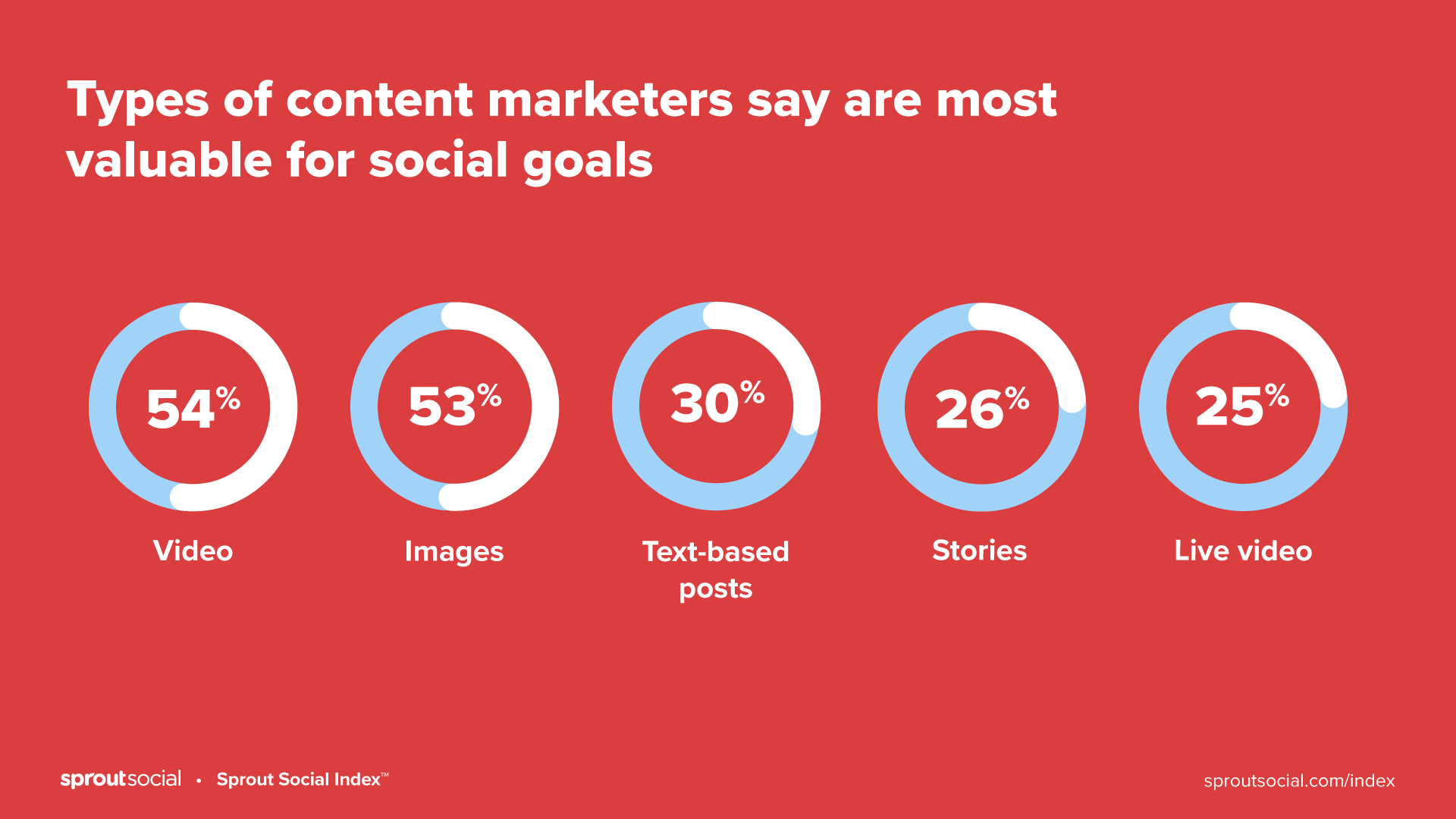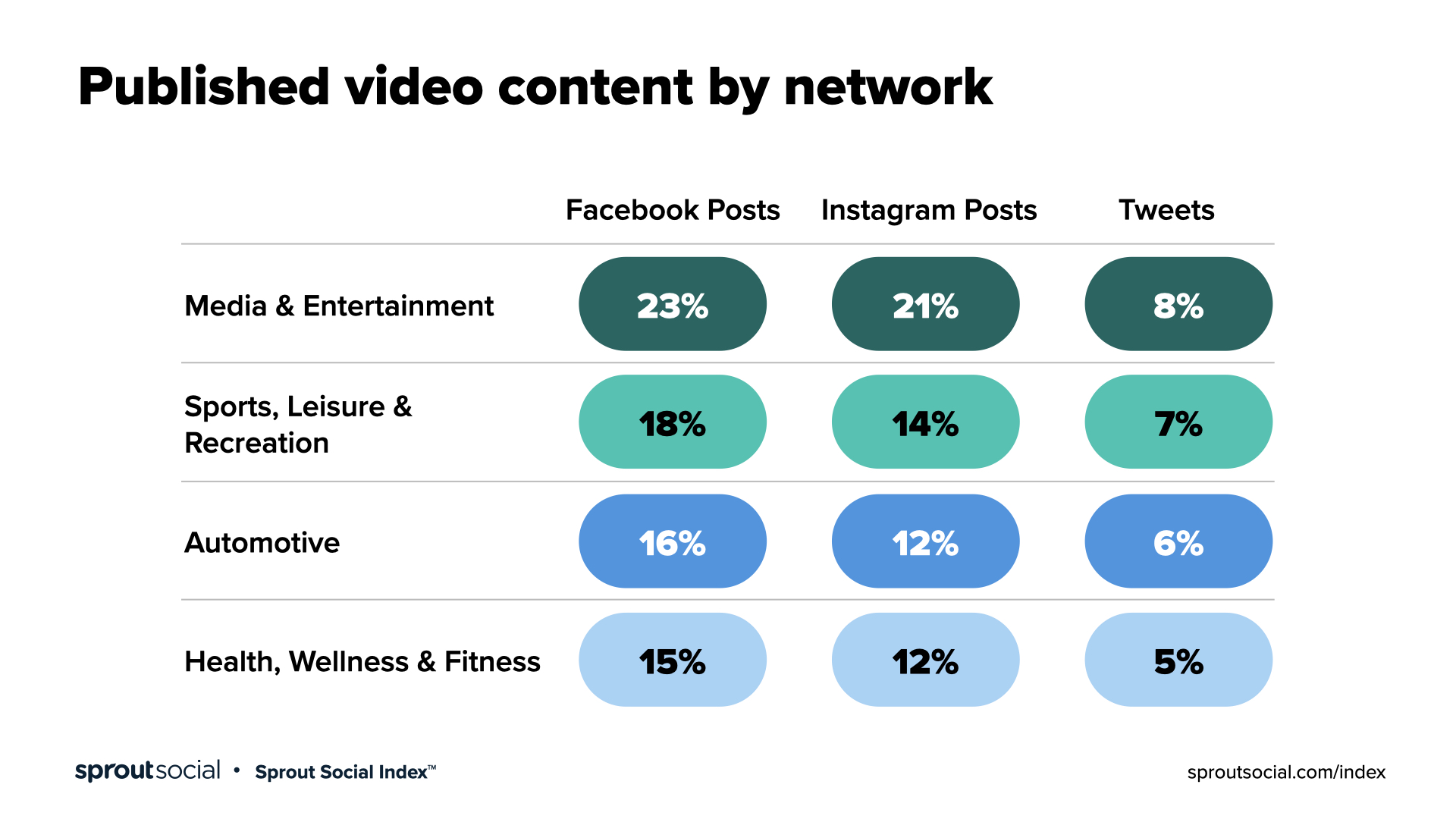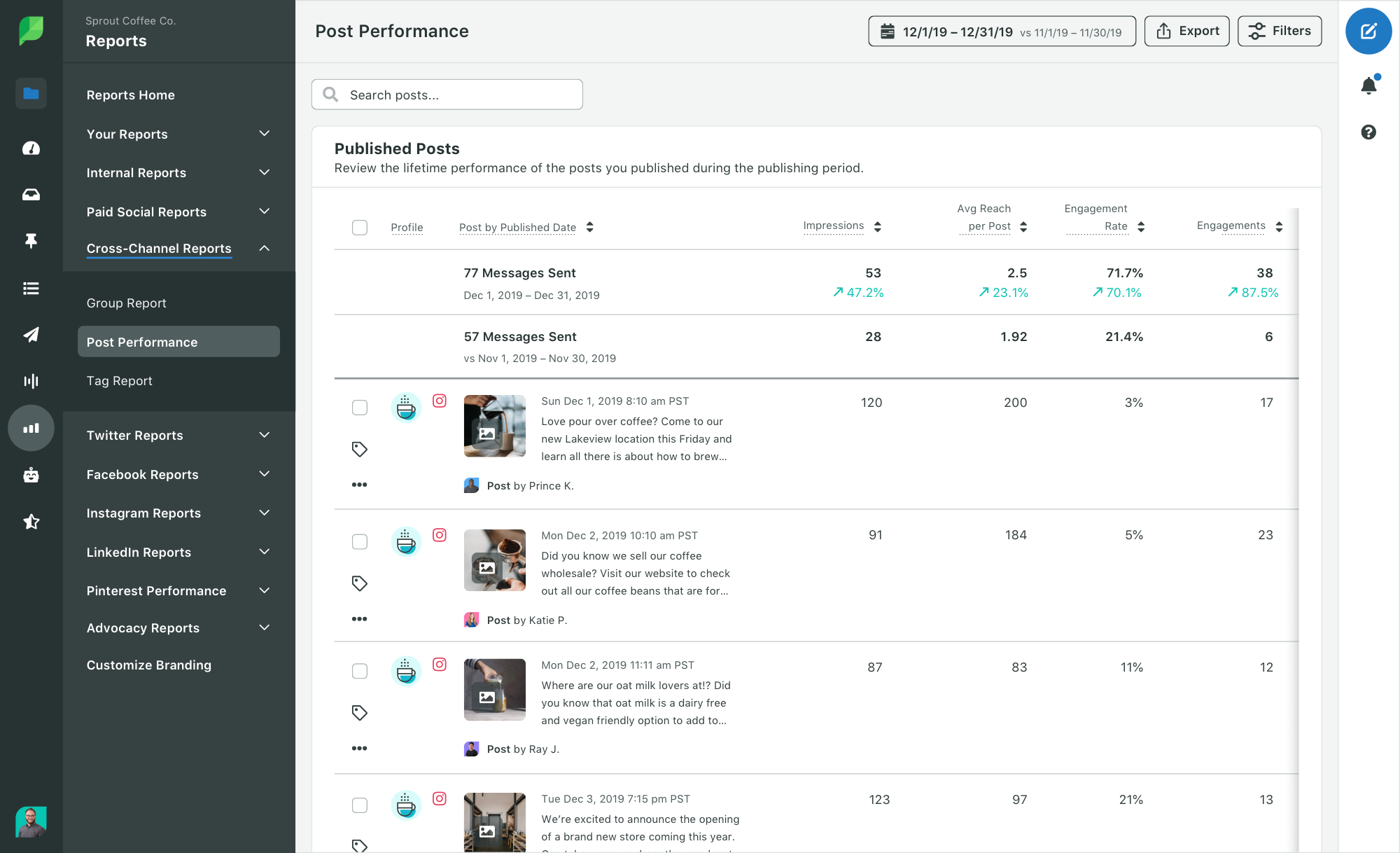Ninety-three percent of marketers acknowledge that social media accelerated competition within their industry in the last year. So, what’s one of the keys to standing out from the crowd? Content.
Content is at the heart of every social strategy. It’s how brands make their first and lasting impressions on social. It’s the essential ingredient for how brands communicate and connect with new and loyal customers.
In this article, we’ll walk through the most valuable types of social media content identified by marketers and how you can use social analytics to determine the best types of content for your business.
We’ll show you two ways to find the best types of content that will grow your business: the first is based on data from the Sprout Social Index™, Edition XVII: Accelerate, provided by marketers on their most valuable content types; the second uses social analytics to analyze your social data.
The types of social media content marketers find most valuable in 2021

1. Video
According to 54% of marketers, video is the most valuable content format for achieving social goals.
Despite the growing demand for video among consumers and the value of video in achieving social goals, marketers’ content strategies continue to favor photos and posts containing links. Findings from the Index reveal that overall only 14% of Facebook posts, 11% of Instagram posts and 5% of Twitter posts include video content. When looking at the breakdown of published video content, brands within a few industries are outdoing those benchmarks.

Why video works on social:
Social video content is hot right now, and for good reason. No matter what your goals are for social, video can help you accomplish them.
An overwhelming majority of video marketers say video has helped increase sales, traffic to their website and users’ understanding of their product or service, according to Wyzowl’s 2021 State of Video Marketing Survey.
If your goals are more focused on community engagement, social video content can be a valuable resource to lean on. Instagram videos get 49% more engagement than photo posts. Tweets with video have 10x more engagement than those without. People are also twice as likely to share videos with their friends than any other type of content.
If the popularity of TikTok and Instagram Reels is any indication, successful videos don’t require unlimited time, resources or polish to create. Low-lift, creator-style videos can add a level of relatability that viewers appreciate.
In addition to being able to produce effective, low-lift videos without any major investment, video content can also be repurposed and spun into other content formats. Check out nine tips to get the most from your social media video content here.
Best social platforms for video content:
Facebook, YouTube and Instagram are the top three social media platforms that consumers use to follow brands and want to see brands using more. Instagram in particular has a variety of tools for creating long and short-form videos, which makes it a great arena for testing different video concepts and styles.
You might be wondering, what about TikTok? Individual creators run the show on the platform and brands have yet to really find the sweet spot, but there’s a lot that can be learned from TikTok trends.
4 ways Klarna gets video content right on Instagram
Klarna is a global fintech company that enables smooth shopping by allowing consumers to buy now and pay later. Departing from how you might think of traditional finance brands, Klarna is colorful, fun and killing the social video marketing game on Instagram. They post consistently and aren’t afraid to experiment with Reels, IGTV and video in Stories. Here are a few reasons their Instagram video content goes above and beyond:
- They collaborate with popular, yet relatable influencers and brand partners to create videos, making for a diverse collection of content.
- They leverage video series like Expert Q&As featured on the UK account, and “Let’s Kiki with Klarna” for Pride month in the US.
View this post on Instagram
- The brand has several geo-specific accounts, for which all video content is tailored to those regions in the topics they touch on, influencers they partner with and the products they promote.
- They’re using their Instagram-first, #GetSmoooth campaign to test the waters on TikTok.
@klarna After months of hibernating, @wisdm8 flexes his style. Use the audio and #GetSmoooth with Klarna. ?
? Get Smoooth with ASAP Rocky – klarna
2. Images
Images are a very close second in the rankings of the most valuable content format. They’re also the most frequently posted content type across social networks.
Unlike most videos, still images can be absorbed and appreciated in an instant. The colors, composure, text or (lack thereof) and other details give social users an immediate impression of your brand.
Why images work on social:
I don’t know about you, but I’d rather look at a picture than read a thousand words. The majority of social media users will feel that way too, as they crave convenience, accessibility and brevity.
These days, mobile devices are equipped with high-definition cameras and editing tools, so anyone can embrace their inner photographer. That means social media marketers can take the reins on creating images for their content strategy without enlisting a ton of resources. It’s also opened the door for consumers to contribute high-quality user-generated content (UGC) for their favorite brands.
UGC images add another dimension to a brand’s visual identity, while also building community and relatability between a brand and social users.
Best social platforms for images:
Marketers should include images in the content strategy for every social network they use, but Instagram and Pinterest naturally lend themselves to visuals and have a few unique advantages.
Though it has evolved to be much more, Instagram started as an image sharing platform. Data from the Sprout Social Index™ found that images make up 87% of Instagram content shared by marketers. Given that 48% of consumers want brands to use the platform more, consider increasing the frequency of the images you publish to remain competitive.
Only 20% of consumers follow brands on Pinterest, but that shouldn’t deter marketers from sharing images there. The majority of Pinterest users aren’t searching for a brand, they’re looking for inspiration. In fact, 97% of all searches on the platform are unbranded. Pinterest users go to the platform with an open mind and eyes peeled for visual content that sparks their interest (and future purchases). Both Pinterest and Instagram also have social commerce features that allow marketers to tag products, transforming images into shoppable content.
3 ways Williams Sonoma uses images to drive engagement and social commerce
Williams Sonoma, known for its kitchenware, home furnishing and gourmet foods, maintains strong followings, a clear, reputable brand identity and shoppable feeds across social platforms. They achieve that with sumptuous, vibrant images in the following ways:
- Recipes, dinner ideas and cooking-related searches are consistently among the top Pinterest trends. Williams Sonoma creates Pins and carousels that feature colorful dishes and recipes in captions. Click on the image and voila! You end up on Williams Sonoma’s website, where you can see which products you might need to complete the dish and become a master chef.
- On Instagram, users can simply shop product tags, so if they like what they see, they can get it with just a few taps.
- Across all platforms, captions enhance the visual details and always include a CTA linking to their blog or online store.
Hosting brunch? Impress with this puff pastry toast. It looks fancy but is SO easy to assemble.
Tomato, Feta & Herb Pastry Toast: https://t.co/zkFk5V47KZ
Newlywed Entertaining Cookbook: https://t.co/pq830jC6iW pic.twitter.com/6amhSIPSGO— Williams Sonoma (@WilliamsSonoma) June 27, 2021
3. Text-based posts
It’s important for businesses to prioritize visual content, but they shouldn’t lose sight of the power of words. Nearly a third of marketers say text-based posts are the most valuable type of content.
Written content needs the same attention and consistency that you give other content formats and creative elements. Developing a distinctive brand tone and voice that aligns with your visual brand will help your written content stand out from the crowded social chatter.
Why text-based posts work on social:
Consumers want information—53% of consumers like or follow brand pages on social to learn about new products or services and 52% do so to stay up to date on company news. Text posts are the most direct way to give that to your followers.
When brands demonstrate an understanding of what customers want and need, 43% of consumers would choose that brand over a competitor. Written content can be extremely valuable for starting conversations that help you get to know your customers better.
Best social platforms for text-based content:
Reddit is a great platform to engage in Q&As and get conversational with your fans. LinkedIn is another natural place to share thought leadership, articles and engage with customers, SMEs, potential investors and more.
Marketers use plain-text posts on Twitter more than any other social media network. Visuals are still prominent on Twitter, but it’s mostly buzzing with conversations. According to David Herman, a Senior Manager for Twitter Sports Partnerships, joining Twitter conversations is the single best thing brands can do to increase their followers. Letting your voice be heard will expose your brand to new audiences, engage your community and let people know what your brand is all about.
4 ways McDonald’s uses Tweets to define its brand voice and start conversations with fans
Everyone knows McDonald’s as one of the most successful fast-casual food chains in the world with millions of customers served each day. On Twitter, the brand communicates with its fans at scale with a relatable, casual, humorous voice that brings the brand down to earth. Here are four reasons why McDonalds’ text posts are wildly popular on Twitter:
- They ask their fans questions and encourage them to engage in fun, on-trend ways.
what’s your drive thru hype song? there are no wrong answers
— McDonald’s (@McDonalds) February 7, 2021
- They use Tweets to collect and act on social feedback directly from their community.
about to present this to my boss do u guys have any feedback? https://t.co/yp3NreJaXy
— McDonald’s (@McDonalds) February 10, 2021
Y’ALL WE DID IT. Hi-C Orange is coming back ? pic.twitter.com/wIaUa6vzPZ
— McDonald’s (@McDonalds) February 10, 2021
- They don’t just post, wait for engagement and leave it at that. The brand adds to conversations threads for nearly every response they get.
- They cross-promote their text Tweets and reinvigorate them on other social platforms using graphic elements.
if u can do this u can have my job
Posted by McDonald's on Thursday, February 25, 2021
4. Stories
Stories aren’t necessarily going to supercharge brand awareness, but they are community engagement gold. Just over a quarter of marketers say stories are the most valuable type of social media content.
Why stories work on social:
In the US, 73% of people agree that Stories enable them to experience new things outside their everyday lives.
Across platforms, stories get top billing on social network interfaces. In addition to prominent placement, the interactive and timely nature of stories makes them highly engaging for consumers. For marketers, the variety of easy-to-manipulate stickers, interactive elements, filters and sounds gives total creative freedom and more room to express their brand personalities.
Best social platforms for Stories:
LinkedIn, Twitter, Snapchat, Facebook and even non-traditional social platforms like Slack have implemented a version of Stories, but Instagram Stories reign supreme. On most platforms, stories “self-destruct” after 24 hours. Instagram, however, allows brands to turn Instagram Stories into Highlights on their profiles.
Additionally, reactions and replies to Instagram Stories go straight to the brand’s DMs, which is a great opportunity to start or build on one-on-one conversations with your fans.
3 reasons to emulate GQ’s sophisticated Instagram Stories strategy
GQ, one of Conde Nast’s many monthly magazines, uses stories to create content that looks and feels like their magazine spreads. Here are some reasons to admire their approach:
- They give readers a sneak peek of their exclusive content so Instagram users are eager to swipe up and get the full story.
- They use interactive sticker elements like polls, questions and quizzes to creatively engage their audience, while simultaneously gaining insights about them, their preferences and needs.
- They are diligent and intentional about creating Instagram Story Highlights. The chic editorial design of each story frame and tap-friendly nature of Stories that seamlessly shifts you from one highlight to the next feels (almost) as if you’re flipping through the pages of a magazine.
5. Live Video
Ongoing digital transformation, accelerated by the events of 2020 and the inability to partake in in-person experiences, has businesses thinking differently about how they can engage with their customers in real-time. Live video came out a winner during the pandemic, but it’s here to stay.
Why live video works on social:
Live video enables businesses and creators to broadcast conversations, performances, Q&As, webinars and other virtual events. Unlike the asynchronous nature of waiting for responses to text or image posts, live streams give audiences a chance to ask questions, comment and react instantaneously.
Live and simultaneous viewing also give people a sense of community and togetherness, something people desperately craved during the pandemic.
On all social networks with live streaming capabilities, marketers can save the recording and repurpose the video to get more value from the content. Check out 10 ways to repurpose your live stream and get more from your content here.
Best social platforms for live video content:
YouTube and Facebook Live both experienced a boom during the pandemic. YouTube’s Culture & Trends Report found that 85% of its users had watched a live stream on the platform over the past 12 months. Facebook reenergized its live streaming capabilities, adding new creator tools, accessibility features and an audio-only mode.
LinkedIn Live is another streaming solution that brands can use to reach more professional networks. On average, LinkedIn Live videos get 7x more reactions and 24x more comments than native videos produced by the same brand.
Who’s doing it well:
Detroit Labs, a custom software development company, has found success through their recurring LinkedIn and YouTube Live series, “Labs Live.” Here are a few ways they’ve mastered the format:
- They stream Labs Live on a monthly basis. Between streams, they make sure to keep the series top-of-mind by promoting both past and upcoming sessions.
- Each Labs Live stream has a clear agenda, a list of guest speakers and descriptions that showcase the value for viewers.
- On YouTube, following the live stream, they add chapter markers to the video description so audiences can easily skip to points of interest.
- They showcase their own employees as thought leaders and also invite external experts to contribute.
- They have fun! Not all live videos have to be expert Q&As or buttoned-up webinars. For example, in March, Detroit Labs did a live version of bracketology, but for snack foods.
How to find your brand’s most successful types of social media content
Just because social media marketers ranked the five content formats above most valuable, doesn’t mean they will be the most successful for your own brand. Each company’s social goals will vary, so each content format’s effectiveness will as well.
Ultimately, you want to share content that your customers want—and for that, you first need to identify the best-performing types of social media content on your priority platforms.
Marketers who understand which content types yield the greatest return are better positioned to create content that stands out from the crowd.
Sprout Social’s robust analytics tools make reporting on content and identifying which formats are most valuable simple. With the click of a button, Sprout’s Post Performance Report reveals a cross-channel performance analysis at the post level to understand what content resonates and why.
Applying Tags to content also gives marketers more granular insights about what compels their audiences to engage. For instance, if a brand wants to test if UGC performs better than official photography or vice versa, they can use the Tag Report to analyze that data.

Accelerate past the competition with content
In a competitive and crowded social landscape, publishing content that’s built around your audience’s preferences is a must. Download The 2021 Content Benchmarks Report to dive deeper into data from the Sprout Social Index™ and shape a social content strategy that speaks directly to your audience.
The post 5 types of social media content that can accelerate business success appeared first on Sprout Social.
